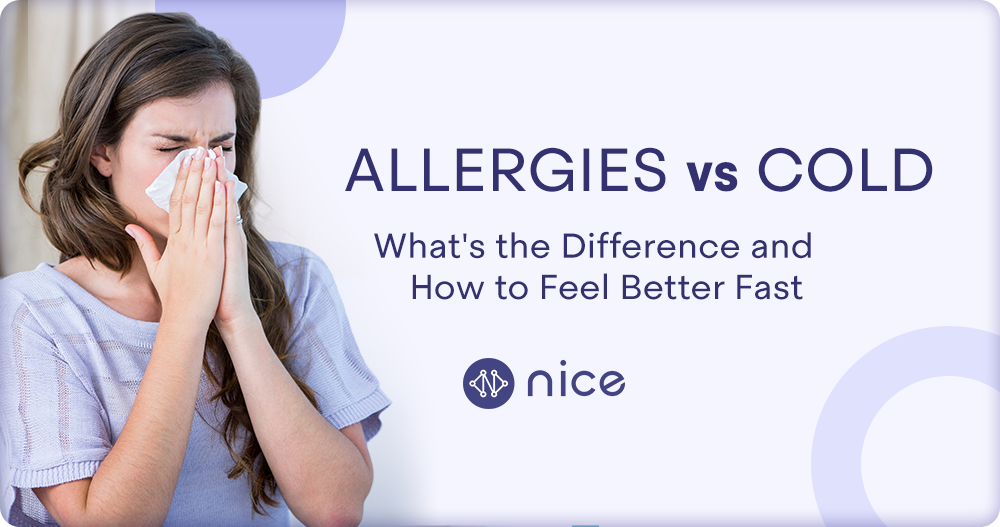Allergies vs Cold: What’s the Difference and How To Feel Better Fast
It can be tough to spot the difference between allergies and colds since they share similar symptoms. But there are a few key ways to tell them apart. Let’s dive into what allergies and the common cold are, what causes them, and how to tell which one is the reason for your symptoms.
What are Allergies?
Allergies are a reaction to (usually) harmless substances in your environment. Common triggers are pollen, pets, dust mites, or mold.
You might get seasonal allergy symptoms in the early spring each year when trees, grasses, or weeds release pollen. You may also get symptoms anytime you enter a new environment like the home of a friend who has a cat.
Allergies can range from very mild to severe, depending on the person. But the most common symptoms include:
Red, itchy, watery, and/or swollen eyes
Itchy nose and/or roof of the mouth
Runny and/or stuffy nose
Sneezing
Coughing
Sore throat
Now that you know what allergies are, let’s explore what a cold is and what it looks like.
What is a Cold?
The common cold is an infection of your nose and throat, caused by one of over 200 different viruses. Most adults can expect to get two or three colds a year. They’re most common in the fall and winter season, but they can happen anytime.
Common cold symptoms include:
Runny and/or stuffy nose
Sneezing
Coughing
Sore throat
Thick green or yellow mucus
Watery eyes
Body aches and pains
Fever (mostly in children)
Colds are generally harmless, even if they don’t feel like it sometimes. You may feel exhausted, generally unwell, and unable to go about your daily routine. But after a few days, you should start to feel better, which brings us to the difference between allergies and the common cold.
Allergies vs. Cold: What’s the Difference?
Here’s how to tell whether it’s a cold or allergies:
Mucus color. With allergies, your mucus should be clear or watery. With a cold, mucus will often be thick and discolored (yellow or green).
Coughing. Allergies can make you cough, but it’s usually a dry cough. With a cold, you’ll likely have a wet cough, producing yellow or green mucus.
Itchy eyes. With allergies, your eyes may be itchy and/or watery. A cold may cause watery eyes, but it typically doesn’t make your eyes itch.
How long your symptoms last. With allergies, your symptoms will stay the same for the entire time you have them, which could be several weeks or longer. When you have a cold, your symptoms will typically change over the course of a few days, improving toward the end of the infection, which usually lasts between seven and 10 days.
When you get symptoms. Have you noticed that you start sneezing around the same time each year, or after going to a certain place? If so, it’s probably caused by allergies. The most common times for seasonal allergies are spring or fall.
Body aches. Allergies don’t typically cause body aches or pain. So if you’re hurting all over, you probably have a cold.
Treatment Options for Allergies and the Common Cold
Some treatments that can help with both allergies and colds are:
Over-the-counter (OTC) allergy and sinus medications. OTC decongestants (like Sudafed) and antihistamines (like Benadryl) can help clear up a stuffy nose or reduce itching associated with both allergies and the common cold.
Cough suppressants and expectorants. Cough suppressants like Robitussin, and expectorants like Mucinex can help minimize your cough and thin out mucus, so it’s easier to get out of your system. Try a cough suppressant if you have a dry, hacking cough that keeps you up at night. Opt for an expectorant if you have a wet, productive cough with thick mucus you’re having trouble coughing up.
Sinus rinsing. If you have a stuffy, itchy, and/or runny nose and would rather not take medication, flushing your sinuses can be helpful to relieve both allergy and cold symptoms. You can buy premixed saline and baking soda solutions or mix your own, put them in your Neti Pot or sinus rinse bottle, and flush out your sinuses as needed. Doing this can help clear up congestion and clear out mucus or pollen stuck in your sinuses.
Vitamins and probiotics. Other alternatives to medication are vitamin C and probiotics. Vitamin C might help shorten your recovery time, and it supports your immune system. As for improving allergy symptoms, some people get relief by including probiotics in their diet, which contain healthy bacteria that benefit the whole body. You can find probiotics in foods like yogurt, pickles, or other fermented vegetables.
Get Relief for Your Allergies or Cold in 24 Hours
Being under the weather is no fun. If you want relief but aren’t sure what’s causing your symptoms, it’s never a bad idea to check with your healthcare provider.
Your provider can quickly assess your symptoms and determine the best treatment option for you, helping you feel better faster. And at Nice, it’s as easy as logging into the Nice app and scheduling a virtual visit–typically within a day.
If you’re an employer interested in providing super simplified healthcare to your employees, learn more by visiting our employer page.

